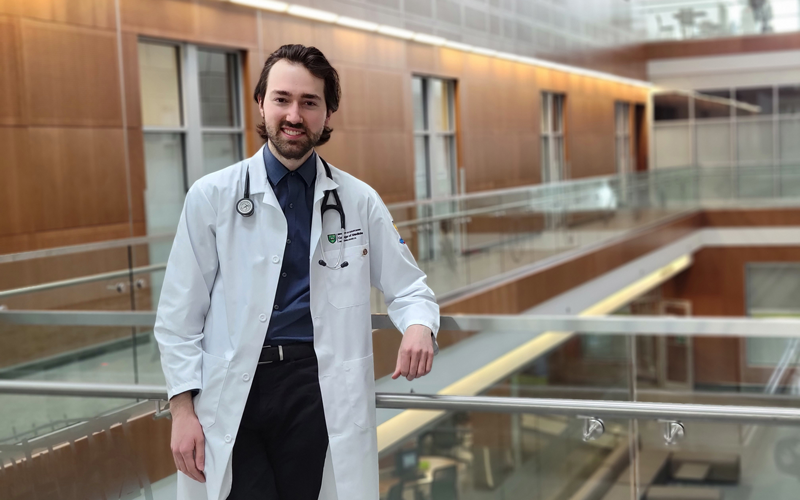
Brandon Spink, Edwards alumnus, and current USask medicine student wins Joule Innovation Grant
Brandon Spink (B.Comm. 2016) received the $10,000 Joule Innovation Grant in the Emerging Physician Innovator category in 2020 following his team’s win in the 2019 Med.Hack(+) hackathon competition for his invention, the Nexagon.
During Spink’s time at the Edwards School of Business, he talked about how he learned a number of valuable content-related skills, but the two most invaluable to his medical studies were the soft skills of understanding the value of interdisciplinary collaboration and the need to think outside the box. After his commerce degree, he realized he was not finished learning and as he had always been interested in health, he applied for medical school.
In his medical studies, Spink realized clinical issues are best solved through viewing the problems through multiple sets of eyes. "We all have blind spots in our training and solving patient problems in teams helps address this potential deficit as well as allows us to think about alternative solutions."
Spink had always been interested in finding innovative solutions to existing problems. "My first foray into innovation resulted as an undergraduate in commerce when I partnered with a computer science student to develop an app for determining nutritional requirements for recovery following a workout," said Spink. "While this app never made it past the prototype stage, it piqued my interest to keep looking for problems to solve."
Therefore, after hearing about the hackathon from medical students who previously participated, he joined a team that would search for innovative solutions for the risk of concussions.
"The problem that was most intriguing to me was that there currently are no solutions that effectively prevent and/or mitigate the risk of concussions caused by whiplash related events in sports," said Spink.
The hackathon is an event designed to solve problems in healthcare using technology. It allows students to prototype solutions to real-life issues that are posed by presenters over the course of 48-hours. During these 48-hours Spink along with his teammates Richard Ngo a fellow medical student, Andres Erazo, a current Ph.D. student in biomedical engineering at USask, and Gabriel, a mechanical engineering student at the Universidad de las Fuerzas Armadas in Ecuador created the Nexagon.
The Nexagon acts as a protective collar to address one of the key causes of concussions, rapid rotation of the head and neck. The current form of protection, the helmet only attempts to dissipate the force of a blow to the head, of which outcomes are more likely to be skull fractures, secondary contusions, and epidural hematomas not concussions.
“Our collar directly addresses concussions in the following ways. First, we use elastic materials in our collar to take advantage of its ability to absorb the impact of a collision by translating the impact energy into the deformation of the collar. Second, we recognize the importance of shapes that occur in nature naturally. For instance, the beehive's internal structure is a densely packed group of hexagonal prisms. This specific structure has been shown to be collision-resistant, and its internal emptiness allows for a controlled space for deformation. This non-Newtonian design allows absorption of the impact energy by levels until the impact has been dampened allowing the collar to return to its initial state after a strong impact, for subsequent uses."
The Joule Innovation Grant hosted by the Canadian Medical Association (CMA), provided Spink an invaluable opportunity for funding to further test and validate working models for the Nexagon. Along with the grant, the mentorship associated with it would be extremely helpful in navigating this innovative space in the healthcare setting. The grant works by assessing each submission by the Joule Innovation Council with the following criteria:
- Improves health outcomes for patients, physicians, and the overall health care system.
- Transformation of current health care approaches.
- Potential for the adoption and use within Canada and beyond.
- Advance patient-centered care through meaningful stakeholder engagement.
In addition to the criteria, there were 247 total entries from across Canada. Spink was selected as one of 12 recipients of a Joule Innovation Grant in the Emerging Physician Innovator category.
As for the Nexagon, Spink’s team is still in the R&D stage, with their ultimate goal of bringing the neck collar to market.
"We believe several stakeholders will benefit from the use of the Nexagon in the sporting arena," said Spink. "These include athletes, parents, sports leagues, healthcare providers, and the healthcare system generally."
Spink plans to continue other entrepreneurial opportunities in the healthcare space. He is currently involved with Novita Medical Innovations Inc. as a co-founder. Novita is an interdisciplinary R&D company that exists to innovate techniques and technologies in the medical device industry.
